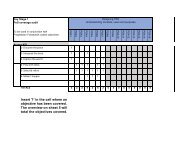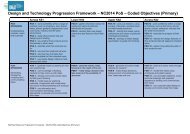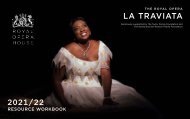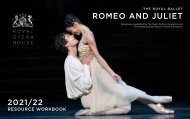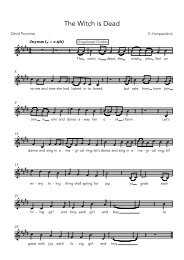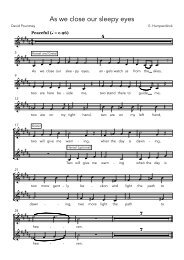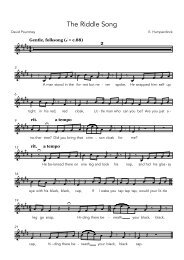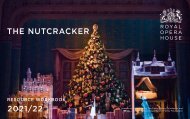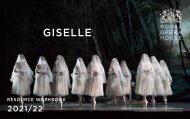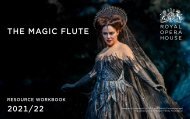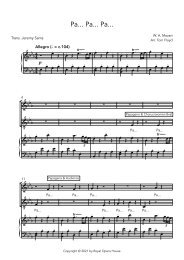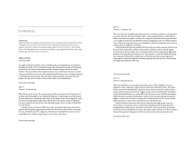ROH_DC_Resource_Book_2018-19_MR
- No tags were found...
You also want an ePaper? Increase the reach of your titles
YUMPU automatically turns print PDFs into web optimized ePapers that Google loves.
ROYAL OPERA HOUSE<br />
DESIGN<br />
CHALLENGE<br />
(SECONDARY)<br />
TEACHER<br />
RESOURCE<br />
BOOK
CONTENTS<br />
03 Introduction<br />
10 Discover the Piece<br />
16 Interpret the Story<br />
20 Explore the World<br />
24 Play with Ideas<br />
28 Select and Refine<br />
32 Make it Happen<br />
37 Project Summary<br />
INTRODUCTION<br />
Before you start the Design Challenge (Secondary) project, use the resources in this section to<br />
introduce the Royal Opera House, The Royal Ballet, the roles of the Set Designer and Costume<br />
Designer, and the design brief.<br />
Welcome to Design Challenge<br />
The Royal Opera House’s prestigious annual<br />
Design Challenge competition is aimed at the<br />
next generation of aspiring set and costume<br />
designers and makers. The programme<br />
provides students with a real practical insight<br />
into opera and ballet, the world-class Covent<br />
Garden stage and the creative processes<br />
behind performance.<br />
Taking part in Design Challenge will help<br />
develop students’ skillset and extend their<br />
learning from educational settings to a<br />
professional context, encouraging them to<br />
open their eyes to the skills required for a<br />
career in backstage theatre crafts.<br />
The Design Challenge project can be delivered<br />
at 3 levels- Further Education, Secondary and<br />
Primary. Design Challenge (Secondary) is for<br />
GCSE students of Art, Craft & Design, Product<br />
Design, Design & Technology and Textiles,<br />
and the project can be used as a mock exam<br />
module in your school setting.<br />
All participating schools will have the<br />
opportunity to submit their shortlisted<br />
students’ work to the Royal Opera House for<br />
judging in the Design Challenge competition.<br />
Royal Opera House: Design Challenge <strong>2018</strong>/<strong>19</strong> (Secondary) 3
The Process<br />
Students that take part in Design<br />
Challenge (Secondary) will follow either<br />
the Costume Design Pathway or the Set<br />
Design Pathway. This resource book will<br />
take you through the six fundamental<br />
stages of designing for opera and ballet:<br />
Each of the six stages has a number<br />
of activities, videos and resources that<br />
can be found in this book. Different<br />
institutions will have different time frames<br />
to complete the project in, and therefore<br />
we advise that you map the project out<br />
against your awarding body’s assessment<br />
objectives and your timetable.<br />
We suggest that you aim to use your<br />
lesson times for the creative, practical<br />
exercises. Many of the research activities,<br />
supported by video resources, can be<br />
set for homework. You may wish to<br />
plan in discussion time at the start of<br />
each lesson to recap and reflect on the<br />
self-led activities.<br />
l Discover the Piece<br />
l Interpret the Story<br />
l Explore the World<br />
l Play with Ideas<br />
l Select and Refine<br />
l Make it Happen<br />
Project Timeline<br />
Thursday 13 September <strong>2018</strong>:<br />
Design Challenge (Secondary) CPD<br />
September – February 20<strong>19</strong>:<br />
Project Delivery in School<br />
Thursday 14 February 20<strong>19</strong>:<br />
Deadline for Finalists<br />
Online Submission<br />
Friday 1 March 20<strong>19</strong>:<br />
Design Challenge<br />
Winners Announcement<br />
Thursday 23 March 20<strong>19</strong>:<br />
Winners Day at Royal Opera House:<br />
Romeo and Juliet Schools Matinee<br />
The Challenge<br />
At the start of the project, you will<br />
set your students the brief with<br />
either the Set Design or the Costume<br />
Design letter from Kevin O’Hare.<br />
Example letters on pages 5 and 6<br />
Dear Designer,<br />
My name is Kevin O’Hare and I am the Director of The Royal Ballet.<br />
Thank you for taking on my challenge to design a setting for Romeo and<br />
Juliet. Please read my design brief carefully and make sure you understand<br />
what you need to do to get started with the challenge.<br />
Set Design Brief<br />
1. Produce a portfolio (or sketchbook) showing your initial ideas on the<br />
themes and background of Romeo and Juliet. Apply this research into a final<br />
design concept for the whole production with an outline and artist drawing<br />
of each setting, one of which you will choose to produce as a model box.<br />
Your research should show your personal – as well as artistic – response to<br />
the themes and context of the ballet, and should communicate set design<br />
ideas for a production to be staged at the Royal Opera House. I will be very<br />
interested to understand the reasons for your design choices<br />
2. Construct a detailed model box to demonstrate your final design for one<br />
setting. You can choose whether you would like to produce this in a 1:50, 1:75<br />
or 1:100 scale – model box templates can be downloaded here. Your final<br />
design should be for one setting within the narrative of the ballet.<br />
You will need to complete both parts 1 and 2 of the challenge.<br />
I look forward to seeing your designs- remember, it’s really important to have<br />
done your research, and to try out lots of ideas before you decide on what<br />
your final design will look like- your portfolio is every bit as important as your<br />
finished model box.<br />
The very best of luck to you!<br />
Yours sincerely,<br />
Kevin O’Hare<br />
4<br />
Royal Opera House: Design Challenge <strong>2018</strong>/<strong>19</strong> (Secondary)<br />
Royal Opera House: Design Challenge <strong>2018</strong>/<strong>19</strong> (Secondary) 5
Dear Designer,<br />
My name is Kevin O’Hare and I am the Director of The Royal Ballet.<br />
Thank you for taking on my challenge to design costumes for Romeo and<br />
Juliet. Please read my design brief carefully and make sure you understand<br />
what you need to do to get started with the challenge.<br />
Costume Design Brief<br />
1. Produce a portfolio (or sketchbook) that shows initial ideas on the themes<br />
and background of Romeo and Juliet. Explore a range of initial ideas before<br />
producing final sketches of costume designs for three characters, and then<br />
select one of these to construct. Your research should show your personal –<br />
as well as artistic – response to the themes and context of the ballet.<br />
2. Construct a costume, or a section of a costume, that could be worn by one<br />
of these characters in a scene. Your final design may be delivered as a<br />
full-size or a quarter-size garment on a model, or could be a section of the<br />
garment such as a sleeve, cuff or accessory. You should also explain why you<br />
have chosen this scene and how your costume relates to the character in that<br />
scene.<br />
You will need to complete both parts 1 and 2 of the challenge.<br />
I look forward to seeing your designs- remember, it’s really important to have<br />
done your research and to try out lots of ideas before you decide on what<br />
your final design will look like- your portfolio is every bit as important as your<br />
finished garment.<br />
The very best of luck to you!<br />
Yours sincerely,<br />
Kevin O’Hare<br />
Royal Opera House<br />
The Royal Opera House aims to enrich people’s<br />
lives through opera and ballet. Home to two of<br />
the world’s great artistic companies – The Royal<br />
Opera and The Royal Ballet, performing with<br />
the Orchestra of the Royal Opera House – we<br />
seek to always be accessible and engaging, to<br />
develop audiences across the UK and to break<br />
new ground in the presentation of lyric theatre.<br />
The Royal Opera House is committed to<br />
enabling as many people as possible to<br />
experience and enjoy world-class ballet. Each<br />
Season more than 740,000 people attend<br />
performances at the Royal Opera House; 33,000<br />
people participate in Learning and Participation<br />
events ranging from Monday Moves for blind<br />
and partially sighted people to Chance to Dance<br />
for talented children from diverse backgrounds.<br />
Many hundreds of thousands across the UK and<br />
overseas tune in to BBC radio and television<br />
broadcasts; more than 47,000 attend our free<br />
outdoor BP Big Screens – live relays from the<br />
Royal Opera House; and a further 730,000<br />
have been able to watch our productions in<br />
cinemas worldwide.<br />
The Royal Ballet<br />
The Royal Ballet is one of the great ballet<br />
companies of the world. Under the leadership<br />
of Director Kevin O’Hare, grand balletic<br />
tradition and an illustrious heritage are united<br />
with innovation, daring and exceptional<br />
standards of artistry, creativity and stagecraft<br />
to produce supreme theatre. It is a beacon in<br />
the cultural life of Britain and a driving force<br />
behind the development of ballet as an art<br />
form. From The Royal Ballet’s base at the Royal<br />
Opera House in London’s Covent Garden,<br />
today’s most dynamic and versatile dancers<br />
come together with a world-class orchestra<br />
and leading choreographers, composers,<br />
conductors, designers and creative teams to<br />
share an awe-inspiring theatrical experience<br />
with diverse audiences worldwide. The<br />
Company’s commitment to enriching people’s<br />
lives through ballet is reflected in the deep<br />
relationships it forges through digital and<br />
learning platforms and international touring. The<br />
extensive repertory of The Royal Ballet follows<br />
a unique trajectory from <strong>19</strong>th century classics<br />
to the singular legacy of works by Founder<br />
Choreographer Frederick Ashton and Principal<br />
Choreographer Kenneth MacMillan and the<br />
compelling new canon of work by Resident<br />
Choreographer Wayne McGregor, Artistic<br />
Associate Christopher Wheeldon and Artist in<br />
Residence Liam Scarlett. Along with innovative<br />
commissions and choreographic initiatives by<br />
The Royal Ballet Studio Programme and strong<br />
links with The Royal Ballet School, the Company<br />
continues to refresh and surprise.<br />
6<br />
Royal Opera House: Design Challenge <strong>2018</strong>/<strong>19</strong> (Secondary)<br />
Royal Opera House: Design Challenge <strong>2018</strong>/<strong>19</strong> (Secondary) 7
ACTIVITY 1: The Role of a Designer<br />
Before your students get started on researching the Royal Opera House, The Royal Ballet and<br />
Romeo and Juliet, it is important that they understand their role as a Designer of set or costume.<br />
You should show them both of these videos:<br />
<strong>ROH</strong> Design Challenge: Set Design film<br />
https://www.youtube.com/watch?v=GUyzdZrQ-vM&feature=youtu.be<br />
Washington National Opera: Costume Design film<br />
https://www.youtube.com/watch?v=SD6485D6kbA<br />
Reflection Questions:<br />
l What is the Royal Opera House?<br />
l What is ballet?<br />
l What can you find out about the history of ballet?<br />
l What do you think Set Design/Costume Design means?<br />
l What is a model box? Why do designers make a model box?<br />
l How would a Director and Designer work together?<br />
You may wish to brainstorm these questions quickly as a class, for you to<br />
revisit later in your design project.<br />
Optional Trips to Support this Project<br />
You might want to organise a field trip with your students, to visit a local theatre or<br />
production site where sets and costumes are made. The Royal Opera House’s sets and<br />
costumes are made at High House Production Park. Click here to find out more.<br />
Student Portfolio Checklist:<br />
l Student’s notes about what they have learned about the Royal Opera House,<br />
The Royal Ballet, Set Design and Costume Design<br />
l Initial personal response and understanding of the Design Challenge project<br />
l Letter from Kevin O’Hare, stuck in and annotated<br />
Royal Opera House: Design Challenge <strong>2018</strong>/<strong>19</strong> (Secondary) 9
STAGE 1<br />
DISCOVER THE PIECE<br />
Use the activities in this section to explore the repertoire for this<br />
year’s Design Challenge. Your students will visually respond to<br />
the music, learn about the story and research relevant artists.<br />
ACTIVITY 2: Draw to Music<br />
Choose a piece of music from Romeo and<br />
Juliet. Click here. With a drawing pencil and<br />
paper, ask the students to respond to the<br />
music on the page. Their response should be<br />
abstract, not figurative. Where is their starting<br />
point? How do their pencil strokes change?<br />
Why? After a couple of minutes, stop the<br />
music and ask:<br />
l How did the music make them feel? What<br />
could be happening? Ask them to talk about<br />
the marks they have made on their paper. Pick<br />
a few to share, and then ask them to discuss<br />
what they have produced in pairs.<br />
They can work straight into their portfolio and<br />
can add annotations if they choose to. Now<br />
that they understand the concept of visually<br />
responding to the music, repeat the exercise<br />
with one or two more clips. You might wish to<br />
do this with a piece of music from each act of<br />
the piece. Students continue to make marks<br />
with chalk, paint, crayons, charcoal, pencils.<br />
Keep reminding them that their work doesn’t<br />
need to be neat or pretty. Whatever media<br />
they are using, they need to stay true to the<br />
music.<br />
ACTIVITY 3: Discussing the<br />
themes of Romeo and Juliet<br />
Give out the synopsis of Macmillan’s Romeo<br />
and Juliet and ask the students to discuss<br />
in groups what they think the themes of the<br />
story are? Which of the themes do they most<br />
relate to? Why? If you have time, you might<br />
want to lead a visual response to some of<br />
these themes in their portfolio.<br />
Minimum suggested time: 90 minutes<br />
Royal Opera House: Design Challenge <strong>2018</strong>/<strong>19</strong> (Secondary)<br />
11
RESOURCE: Romeo and Juliet Synopsis<br />
ACT I<br />
Scene 1: The market place<br />
Romeo, son of Montague, tries unsuccessfully to<br />
declare his love for Rosaline and is consoled by his<br />
friends Mercutio and Benvolio. As day breaks and<br />
the townspeople meet in the market place, a quarrel<br />
develops between Tybalt, a nephew of Capulet, and<br />
Romeo and his friends. The Capulets and Montagues<br />
are sworn enemies and a fight soon begins. The<br />
Lords Montague and Capulet join in the fray, which is<br />
stopped by the appearance of the Prince of Verona,<br />
who commands the families to end their feud.<br />
Scene 2: Juliet’s ante-room in the Capulets’ house<br />
Juliet, playing with her nurse, is interrupted by her<br />
parents, Lord and Lady Capulet. They present her to<br />
Paris, a wealthy young nobleman who has asked for<br />
her hand in marriage.<br />
Scene 3: Outside the Capulets’ house<br />
Guests arrive for a ball at the Capulets’ house.<br />
Romeo, Mercutio and Benvolio, disguised in masks,<br />
decide to go in pursuit of Rosaline.<br />
Scene 4: The ballroom<br />
Romeo and his friends arrive at the height of the<br />
festivities. The guests watch Juliet dance. Mercutio,<br />
seeing that Romeo is entranced by her, dances<br />
to distract attention from him. Tybalt recognizes<br />
Romeo and orders him to leave, but Capulet<br />
intervenes and welcomes him as a guest in his<br />
house.<br />
Scene 5: Outside the Capulets’ house<br />
As the guests leave the ball, Capulet restrains Tybalt<br />
from pursuing Romeo.<br />
Scene 6: Juliet’s balcony<br />
Unable to sleep, Juliet comes out on to her balcony<br />
and is thinking of Romeo when suddenly he appears<br />
in the garden. They confess their love for each other.<br />
ACT II<br />
Scene 1: The market place<br />
Romeo can think only of Juliet, and, as a wedding<br />
procession passes, he dreams of the day when he<br />
will marry her. In the meantime, Juliet’s nurse pushes<br />
her way through the crowds in search of Romeo to<br />
give him a letter from Juliet. He reads that Juliet has<br />
consented to be his wife.<br />
Scene 2: The chapel<br />
The lovers are secretly married by Friar Laurence,<br />
who hopes that their union will end the strife<br />
between the Montagues and Capulets.<br />
Scene 3: The market place<br />
Interrupting the revelry, Tybalt fights with Mercutio<br />
and kills him. Romeo avenges the death of his friend<br />
and is exiled.<br />
ACT III<br />
Scene 1: The bedroom<br />
At dawn next morning the household is stirring and<br />
Romeo must go. He embraces Juliet and leaves as<br />
her parents enter with Paris. Juliet refuses to marry<br />
Paris and, hurt by her rebuff, he goes off. Juliet’s<br />
parents are angry and threaten to disown her. Juliet<br />
rushes to see Friar Laurence.<br />
Scene 2: The chapel<br />
Juliet falls at the Friar’s feet and begs for his help. He<br />
gives her a phial of potion which will make her fall<br />
into a deathlike sleep. Her parents, believing her to<br />
be dead, will bury her in the family tomb. Meanwhile<br />
Romeo, warned by Friar Laurence, will return under<br />
cover of darkness and take her away from Verona.<br />
Scene 3: The bedroom<br />
That evening Juliet agrees to marry Paris; but the<br />
next morning when her parents arrive with him they<br />
find her apparently lifeless on the bed.<br />
Scene 4: The Capulet family crypt<br />
Romeo, who has not received the Friar’s message,<br />
returns to Verona stunned by grief at the news of<br />
Juliet’s death. Disguised as a monk, he enters the<br />
crypt, and finding Paris by Juliet’s body, kills him.<br />
Believing Juliet to be dead, Romeo drinks a phial<br />
of poison. Juliet awakes and, finding Romeo dead,<br />
stabs herself.<br />
ACTIVITY 4: Artist Research<br />
Select art books that focus on artists who<br />
were/are working from the following periods:<br />
1 During the period the piece was written<br />
and broadly from the same continent<br />
or country<br />
2 At the time and/or place that the piece<br />
is set is different from above<br />
3 A contemporary artist working today<br />
who might have parallels or give insights<br />
to the themes of the piece<br />
Allow students time to look through these<br />
books, quickly sketching images which interest<br />
them. There should be enough books so that a<br />
minimum of 4 students can look at one book<br />
at the same time. Encourage students to focus<br />
on small or specific details; the cuff of a dress,<br />
the composition of a painting, the brushwork<br />
or technique itself etc. These sketches should<br />
be annotated to assist analysis later on. After<br />
10 minutes, ring a bell and ask every student<br />
Top Tips: How to<br />
Discover More<br />
About the Piece<br />
As well as hearing the music and<br />
understanding the story, your students<br />
should extend their research to:<br />
l Choreography<br />
l Composer<br />
l Period<br />
l Relevant Artists<br />
l Other Productions of<br />
Romeo and Juliet<br />
to swop to a different book and peiod.<br />
The students should collect a couple of<br />
sketches from each category.<br />
The sketches should be a springboard for<br />
discussion surrounding the issues of:<br />
l How to choose what to research next<br />
l For initial design ideas, taking<br />
inspiration from other artists<br />
l For insight into how we look<br />
through different lenses of history<br />
This kind of research can lead students into<br />
new territory and is particularly effective<br />
at the beginning of the research phase or if<br />
someone has become stuck. The trick is to<br />
look for detail which interests visually, without<br />
overthinking it in the moment. Some ideas<br />
will not be of direct use but there may<br />
be a small kernel of an idea which forms<br />
as a result.<br />
Portfolio checklist:<br />
l At least one drawing response<br />
to music<br />
l Evidence of research from<br />
a range of sources including<br />
sketches and notes<br />
Reflection Questions:<br />
l What have you learned about<br />
using music to inspire design?<br />
l What parts of your research have<br />
inspired you so far?<br />
l Is here anything you have learned<br />
that has surprised you?<br />
KENNETH MACMILLAN<br />
12<br />
Royal Opera House: Design Challenge <strong>2018</strong>/<strong>19</strong> (Secondary)<br />
Royal Opera House: Design Challenge <strong>2018</strong>/<strong>19</strong> (Secondary) 13
ADDITIONAL RESOURCES<br />
An Introduction to Romeo and Juliet<br />
(The Royal Ballet)<br />
This video takes a closer look at some of<br />
the characters in Romeo and Juliet, showing<br />
rehearsal footage and interviews with the<br />
dancers. Although there is some footage from<br />
the production, remind your students that<br />
they will be re-imagining the ballet in this<br />
project, not copying the original designs.<br />
https://www.youtube.com/watch?v=dJwA2idPqnY&t=40s<br />
How Kenneth Macmillan turned Romeo<br />
and Juliet into a Ballet (The Royal Ballet)<br />
This video explores how the relationship<br />
between Romeo and Juliet develops over the<br />
course of the ballet, by taking a closer look at<br />
each pas de deux. Remind the students that<br />
the costumes and sets that they will design<br />
will need to reflect the narrative, the emotions<br />
and the tensions of the piece.<br />
https://www.youtube.com/watch?v=XQ2g5NXq0QI<br />
Dance Costume Design (The V&A)<br />
This article takes a look at the different types<br />
of costumes designed and made for dance,<br />
using the V&A’s collections.<br />
http://www.vam.ac.uk/content/articles/d/dance-costume-design/<br />
Royal Opera House: Design Challenge <strong>2018</strong>/<strong>19</strong> (Secondary) 15
Minimum suggested time: 180 minutes<br />
RECAP:<br />
Ensure the students have read the Romeo and<br />
Juliet synopsis.<br />
ACTIVITY 5: Storyboarding<br />
It is important to storyboard the ballet<br />
because this will turn the written story into a<br />
visual story. It will also get the students used<br />
to exerting their role as a Designer to the<br />
ballet’s narrative.<br />
https://www.youtube.com/watch?v=Rvhz0lPQKAU<br />
Show your students the ‘How To Create a<br />
Storyboard’ (click above) film and explain<br />
to them that a storyboard tells the story<br />
visually, scene by scene, and is an important<br />
step in the process of designing sets and<br />
costumes. It is really helpful for designers<br />
to have recorded the story of the opera or<br />
ballet they are designing for, so that<br />
they can keep referring back to the scenes<br />
as their designs develop.<br />
STAGE 2<br />
INTERPRET THE STORY<br />
Drawing on their initial response to the ballet, students will produce a visual storyboard of the piece.<br />
They will explore the Director’s Visions and create a moodboard in response to at least one.<br />
Royal Opera House: Design Challenge <strong>2018</strong>/<strong>19</strong> (Secondary) 17
RESOURCE: Director’s Visions<br />
Once your students have created the storyboard, you can introduce the Director’s Visions.<br />
The Director’s Visions are a key element of Design Challenge and demonstrate the intrinsic<br />
relationship between a Designer and a Director. The Director will have a strong feeling of how<br />
they want to stage the piece and the themes that they want to focus on. Choose 1 of the 4<br />
Director’s Visions below which will help to focus your design ideas:<br />
REMEMBER: Your Set and Costume designs should…<br />
...be another protagonist within the story, not remaining in the background as something merely<br />
aesthetic but enabling, enhancing and facilitating the story. The set provides the space in which<br />
the story unfolds, the distances and hiding places where the characters make their choices.<br />
The costumes reflect the characters personalities, their history, their secrets. Remember that<br />
visual aids help us understand psychological situations and changes; in which case the sets and<br />
costumes are the most important visual aids we have. Every detail of the set and costume should<br />
be there for a reason, to aid the story. Often, less can be more. Giving room to imagination is a<br />
gift to the audience and keeps them involved as the story unfolds.<br />
ACTIVITY 6: Create a moodboard<br />
Using the Director’s Visions, your students will create<br />
at least one mood board as a starting point for their<br />
designs. Show your students the ‘How to Create a<br />
Moodboard’. You may wish to ask the students to<br />
create a moodboard for 3 or 4 of the Director’s Visions<br />
if you have more time to spend on this, but otherwise<br />
they should choose the Director’s Vision that they have<br />
the best initial ideas for.<br />
Vision 1<br />
Romeo and Juliet’s love was doomed from<br />
the start. They didn’t stand a chance. I’d like<br />
to explore this concept through design –<br />
without feeling the need to limit the story to<br />
its original period. How can we demonstrate<br />
that the parents, and society, were always<br />
in control? How can the futility of their<br />
attempts to be together be demonstrated?<br />
Vision 2<br />
Romeo and Juliet is ultimately a story of<br />
young lovers. I want to make a production<br />
that is geared specifically at an audience of<br />
young teenagers today. I want to prove that<br />
ballet is not an outdated art form, but one<br />
that is current and vibrant and a powerful<br />
medium for conveying twenty-first century<br />
dilemmas. Forbidden love is not uncommon<br />
to young people today. I’m interested in<br />
why Juliet’s family may have objected to her<br />
chosen love in a way that young audiences<br />
today would understand. Where can this<br />
story be set? Why are these two families so<br />
determined to keep the young lovers apart?<br />
Where do we see examples of this today<br />
and how can we depict that on stage so<br />
that young audiences will relate to it in an<br />
immediate way?<br />
Vision 3<br />
The story of Romeo and Juliet is a story<br />
of beauty found amidst ugliness. The beauty<br />
of pure love that blossoms in a hostile,<br />
unforgiving environment. I would like the<br />
design of the ballet to depict this. At times<br />
it may feel as though the beauty of true love<br />
will overcome, but ultimately it isn’t enough<br />
and the harshness and cruelty of<br />
their world triumphs.<br />
Vision 4<br />
Everyone knows that the story of Romeo<br />
and Juliet is set in a very particular place<br />
and time. We don’t need to take them out of<br />
that time in order for the story to resonate<br />
with audiences today. Let’s be true to<br />
Shakespeare’s original telling of the story,<br />
but not in a bland, generic way. How can we<br />
make medieval Verona come to life on stage<br />
in a way that perfectly captures one of the<br />
greatest love stories of all time?<br />
Top Tips:<br />
l Brainstorm and discuss what the<br />
Director’s Visions mean to you<br />
l Consider materials, textures and colour<br />
l Be a magpie – your inspiration may<br />
come from the places you least expect<br />
l Revisit your drawings to music –<br />
how can you translate these into<br />
your moodboard?<br />
l Include photographs and your<br />
own drawings<br />
<strong>Resource</strong>s:<br />
Your students will need access to a range<br />
of artistic media; paper in a range of<br />
colours and textures, paints, charcoal,<br />
water colours, fabrics, pens and pencils,<br />
glue, string.<br />
https://www.youtube.com/watch?v=9jTlJ6vzECc<br />
The moodboards can use images, paints, pens, pencils, materials such as foil, cloth, ribbons –<br />
It doesn’t need to be neat and textures should be explored It’s important that the students also<br />
add their own sketches.<br />
Portfolio checklist:<br />
l Storyboard of Romeo and Juliet<br />
l Notes on your Director’s Vision<br />
and your reasons for choosing it<br />
l At least one moodboard relating<br />
to your chosen Director’s Vision<br />
Reflection Questions:<br />
l Why have you chosen your<br />
Director’s Visions?<br />
l What have you learned about the<br />
relationship between a Director<br />
and a Designer?<br />
l After choosing the vision, what are<br />
you most excited about for the next<br />
steps of the process?<br />
18<br />
Royal Opera House: Design Challenge <strong>2018</strong>/<strong>19</strong> (Secondary)<br />
Royal Opera House: Design Challenge <strong>2018</strong>/<strong>19</strong> (Secondary) <strong>19</strong>
STAGE 3<br />
EXPLORE THE WORLD<br />
Minimum suggested time: 60 minutes<br />
Students will use the Director’s Vision to reimagine the world of the ballet. They will quickly<br />
generate ideas for sets or costumes through quick sketches, modelling, rendering and draping.<br />
ACTIVITY 7: 10 Minutes to<br />
Sketch the Vision<br />
At this stage your students will have chosen<br />
Director’s Vision and made a moodboard of<br />
it. Use this activity to quickly generate rough<br />
ideas at the start of the lesson, using the<br />
chosen Director’s Vision as inspiration:<br />
l Set Design: Give the students 9 minutes<br />
to sketch 1 scene from each act<br />
(3 minutes per scene).<br />
l Costume Design: Ask the students to<br />
choose 1 act and give them 9 minutes<br />
to sketch 3 characters’ costumes<br />
Once the time is up, ask your students to<br />
discuss their sketches with a partner, who<br />
should ask them questions about how they’ve<br />
used the vision and identify the stronger and<br />
weaker parts of their designs. You can repeat<br />
this exercise several times if you have time.<br />
Royal Opera House: Design Challenge <strong>2018</strong>/<strong>19</strong> (Secondary)<br />
21
https://www.youtube.com/watch?v=GEcewt2tQ5w<br />
SET DESIGN ACTIVITY 8A:<br />
Working in 3D<br />
Show your students the ‘How to Create a 3D<br />
Model’ video. Click above<br />
From the previous activity, your students are<br />
now going to choose one scene to create in<br />
3D in a model box. They need to consider<br />
the Director’s Vision and the peer feedback<br />
and they can only use card and paper with<br />
masking tape or blue tack to secure their<br />
designs. You might want to omit the use of<br />
scissors as the models don’t need to be neat.<br />
They need to work quickly and problem solve<br />
as they go- how can they make their set stand<br />
up? Can the set be seen by the audience? How<br />
can they change the levels? Is there too much<br />
on the stage? Too little? Give the students no<br />
more than 5 minutes to create their scene,<br />
and make sure they take a photograph to<br />
stick in their portfolio. Your students should<br />
repeat this activity several time in class or for<br />
homework, documenting their designs with<br />
photographs and annotating them in their<br />
portfolios, as they will need to revisit this in<br />
their next session.<br />
COSTUME DESIGN ACTIVITY<br />
8B: Creating a character<br />
Ideally you will have a mannequin or a quarter<br />
mannequin for this exercise.<br />
From the previous activity, your students are<br />
now going to choose one costume to roughly<br />
create on a mannequin. They need to consider<br />
the Director’s Vision and peer feedback and<br />
they can only use newspaper, scissors, pins,<br />
Sellotape or masking tape. They will need to<br />
work quickly and problem solve as they gohow<br />
can they communicate the character they<br />
are designing for? What does the style say<br />
about the period? The character’s story? Think<br />
about the Director’s Vision and what it means<br />
for the character and their costume. Give the<br />
students no more than 5 minutes to create<br />
their paper costume and make sure they take<br />
a photograph to stick in their portfolio. Your<br />
students should repeat this activity several<br />
time in class or for homework, documenting<br />
their designs with photographs and<br />
annotating them in their portfolios, as they<br />
will need to revisit this in their next session.<br />
Portfolio checklist:<br />
l 3 initial sketches of costumes<br />
or settings<br />
l At least 3 photographs of your<br />
rough 3D models or costumes<br />
l Additional notations about what<br />
worked well and what you would<br />
change for next time<br />
Reflection Questions:<br />
l What were the challenges of<br />
transforming your ideas<br />
from 2D to 3D?<br />
l How able did you feel to shape<br />
and develop your ideas in 3D?<br />
22<br />
Royal Opera House: Design Challenge <strong>2018</strong>/<strong>19</strong> (Secondary)
STAGE 4<br />
PLAY WITH IDEAS<br />
Reflecting on the designs in<br />
their portfolio so far, students<br />
will develop their ideas using<br />
the SCAMPER methodology,<br />
considering the practical elements<br />
of set and costume design.<br />
ACTIVITY 9: 5 Minute peer to peer reflection<br />
Ask your students to find a partner and to reflect on their designs and processes from the ‘Explore<br />
the World’ stage. They should each explain their concept and how it links to the Director’s Vision.<br />
Their partner should then feed back, suggesting ‘What Went Well’ and ‘Even Better If.’<br />
ACTIVITY 10: SCAMPER<br />
The ‘Play with Ideas’ stage should see students producing plenty of different ideas and adaptations<br />
before settling on one to pursue. Reminding your students of the brief, encourage them to revisit<br />
their ideas, their moodboards and responses to music to design for three scenes or three characters,<br />
working through the SCAMPER methodology to push and challenge them.<br />
Choose a SCAMPER method<br />
Play with the idea using…<br />
S<br />
SUBSTITUTE:<br />
What could be used instead?<br />
Concept and processes, material,<br />
colour, texture, shape etc…<br />
C<br />
COMBINE:<br />
What can be added?<br />
Techniques, materials, colour,<br />
texture, shape, themes, layering<br />
concepts etc…<br />
A<br />
ADAPT:<br />
How can it be adjusted to suit a<br />
condition or purpose?<br />
Tools/utensils, process, space,<br />
colours etc…<br />
M<br />
MODIFY/MAGNIFY/MINIMISE:<br />
How can it be changed?<br />
Exaggerated, higher, bigger, stronger,<br />
increase frequency, duplicate, reduce,<br />
smaller, distort etc…<br />
P<br />
E<br />
PUT TO OTHER USES:<br />
What else can it be used for other<br />
than the original purpose?<br />
ELIMINATE:<br />
What can be removed or taken<br />
away from it?<br />
Objects, media, materials,<br />
concept etc…<br />
Simplify, remove parts, cut away,<br />
part of etc…<br />
R<br />
REVERSE/REARRANGE:<br />
How can it be turned around or<br />
placed opposite its original position?<br />
Process, interchange materials,<br />
transpose positive and negative,<br />
turn it around, backwards…<br />
Minimum suggested time: 120 minutes<br />
Royal Opera House: Design Challenge <strong>2018</strong>/<strong>19</strong> (Secondary)<br />
25
Activity 11: Making it Practical<br />
One of the criteria in the design brief is that the students’ designs are practical for use on the<br />
stage. For set designs, the dancers need to have space to perform, as well as enter and exit<br />
into the wings. The designs must be in the correct scale to be believable. The audience should<br />
be able to see everything that they are supposed to see. For costumes and garments, the<br />
dancer needs to be considered- can they move in the costume? Is it heavy? Is it suitable, are<br />
they covered in the places they should be? Watch the set or costume film below and ask your<br />
students to write down all of the practical elements that they need to consider in the next steps<br />
of designing their set or costume.<br />
SET DESIGN RESOURCE:<br />
Using Scale<br />
Encourage the students to revisit their designs,<br />
ensuring that the scale of their set is correct for their<br />
model box.<br />
COSTUME DESIGN RESOURCE:<br />
Costume Practicality<br />
Encourage students to consider what the dancers<br />
need to do on stage, the agility of fabric, weight,<br />
heat, hazards. Ask them to revisit their designs and<br />
to develop them, considering their practicality for the<br />
ballet. You could lead on from this by asking students<br />
to research why Designers need to make a toile/muslin<br />
or a white card model, to prepare them for the next<br />
stage of the design process.<br />
https://www.youtube.com/watch?v=BXpW85N3IbI<br />
https://www.youtube.com/watch?time_continue=97&v=zAgWwBM5cIw<br />
Top Tips:<br />
l Don’t play it safe- the best ideas come<br />
when you try things out!<br />
l Go back to listening to the music and<br />
revisit your moodboard<br />
l Keep the Director’s Vision close to you<br />
at all time. If your designs aren’t<br />
suitable for the Vision you have chosen,<br />
then they won’t work for your Director<br />
and you haven’t answered the brief.<br />
l Consider textures colours,<br />
patterns, symbols<br />
Portfolio checklist:<br />
l By the end of this stage the students<br />
will have designs for 3 characters or<br />
3 scenes<br />
l Plenty of evidence of experimentation<br />
with the SCAMPER methodology. This<br />
could be presented through drawings,<br />
scraps of materials and different<br />
fabrics and photographs<br />
l Annotations on designs relating to<br />
what worked and what didn’t, as well<br />
as the practical elements of making<br />
the designs workable for the stage<br />
Reflection Questions:<br />
l How much did your initial idea change during this stage?<br />
l How difficult has it been to make your ideas practical and fit for purpose?<br />
l What has helped with solving problems that have arisen?<br />
Royal Opera House: Design Challenge <strong>2018</strong>/<strong>19</strong> (Secondary) 27
STAGE 5<br />
SELECT AND REFINE<br />
Students will finalize their designs through<br />
making a toile or white card model. They will<br />
problem solve, critique and justify their design<br />
choices using the success criteria.<br />
At this stage, students will finalize their designs through making and finding creative solutions,<br />
they will focus on the practical application and functionality of their ideas. They will do this by<br />
creating a toile (costume design strand) or a white card model (set design strand).<br />
Costume Design Activity:<br />
Making a Toile<br />
Once the student has decided and finalized their<br />
design they will need to make a toile (sometimes<br />
referred to as a muslin) to test and demonstrate<br />
the practicalities of the design, the fit, the<br />
construction and the details and proportion of<br />
the garment.<br />
A toile is an initial mock-up of a garment made in<br />
cheap fabric, to check and alter how the pattern<br />
fits the body before cutting into the nice fabric.<br />
The toile will then serve as the blue print for<br />
construction of the final garment.<br />
Set Design Activity:<br />
Making a White Card Model<br />
Once the student has decided and finalized<br />
their design they will need to make a white card<br />
model to test and demonstrate how they the<br />
design works on stage.<br />
A white card model is made once the design<br />
has been finalized, it can be seen as a threedimensional<br />
‘blueprint’ of the intended design.<br />
Remember: Students can produce a full, half or<br />
quarter size costume or a costume element. The<br />
toile will reflect what the students have chosen<br />
to construct as their final piece.<br />
Top Tips:<br />
l Students should give and document reasons (in their portfolios) for the choices they<br />
are making when problem solving<br />
l You can extend this exercise by asking students to present their toiles / white card<br />
models to a group of peers who can critique functionality, mirroring this stage in the<br />
real design process<br />
l You may wish to introduce a learning plan template for your students to record this<br />
process in, which can be stuck into their portfolios with photographs of their<br />
toile / white card model<br />
Minimum suggested time: 120 minutes<br />
Royal Opera House: Design Challenge <strong>2018</strong>/<strong>19</strong> (Secondary) 29
Activity 12: Success Criteria<br />
Re-cap the success criteria for the Design Challenge final piece, using the letters from<br />
Kevin O’Hare.<br />
Set Design:<br />
l Practicality: good use of space, with<br />
enough room for the dancers to perform<br />
l Appropriate mood using the<br />
Director’s Vision<br />
l The design tells a story<br />
l Correct use of scale<br />
l The design works as a concept with<br />
your designs for the other two scenes<br />
l The design is creative<br />
Costume Design:<br />
l Practicality: the dancer would be able<br />
to perform in the costume<br />
l The costume or garment is believable<br />
and relevant for the character<br />
l The design tells a story<br />
l Good experimentation and justification<br />
of fabrics and colours<br />
l The design works as a concept with your<br />
designs for the other two characters<br />
l The design is creative<br />
Portfolio checklist:<br />
l Photograph of toile or white<br />
card model<br />
l Notes on what worked well and<br />
what you have learnt from practicing<br />
with a toile/white card model<br />
l A plan for the construction of the<br />
final piece, including the materials<br />
and tools that you will use<br />
Reflection Questions:<br />
l How helpful have you found the<br />
toile/white card model process?<br />
l How prepared do you now feel to<br />
successfully make your final piece?<br />
l How confident are you that your<br />
design meets the brief and why?<br />
30<br />
Royal Opera House: Design Challenge <strong>2018</strong>/<strong>19</strong> (Secondary)
ACTIVITY 13: Set Expectations and Prepare<br />
It’s now time for your students to make their final costume/garment or model box. Support students<br />
in organising all of the equipment and materials they need for their exam. Introduce your students<br />
to this list of expectations for the final piece from the Royal Opera House. You should add the<br />
requirements of your specific qualification and awarding body to this list- these however will not be<br />
considered by the Royal Opera House at judging stage.<br />
l Produce either a full or quarter size costume, or a section of a costume like a sleeve,<br />
headdress, accessory or cuff for a character in Kenneth Macmillan’s Romeo and Juliet.<br />
or<br />
l Produce a model box in the scale 1:50, 1:75 or 1:100 for one scene in Kenneth Macmillan’s<br />
Romeo and Juliet.<br />
STAGE 6<br />
MAKE IT HAPPEN<br />
Students will produce their final model box or costume piece.<br />
Top Tips for Making:<br />
l Make sure you have all of the materials and tools that you need.<br />
l Have your production plan and material and equipment checklist with you<br />
and set yourself a time plan<br />
l Be a perfectionist<br />
l Teachers should add their own tips and expectations for their setting and course<br />
Final Outcome<br />
At the end of the ‘Make it Happen’ stage, every student should have a portfolio that coherently<br />
progresses through the six stage of design, and a completed final piece that is a logical progression<br />
from their design journey.<br />
Celebrating the Students’ Success<br />
It’s a good idea to have a celebratory sharing event in school for the students who have completed<br />
the project, such as an exhibition of their work or an assembly with their peers and parents. You may<br />
also wish to round the project off with a trip, such as:<br />
If you are delivering Design Challenge in a module<br />
that has a 5 or 10-hour exam at the end, you should<br />
use this time for the final making.<br />
l Visit the Royal Opera House in Covent Garden or the Production Site in Thurrock<br />
for a Backstage Tour<br />
l Visit the Royal Opera House to watch the Schools Matinee of Romeo and Juliet,<br />
or an alternative ballet or opera<br />
l Watch a Royal Opera House performance in the cinema<br />
Suggested time: 5-10 hour exam time<br />
Royal Opera House: Design Challenge <strong>2018</strong>/<strong>19</strong> (Secondary)<br />
33
RESOURCE:<br />
Design Challenge<br />
Judging Form<br />
RESOURCE: Judging Form<br />
School / College Name: Judging Date: Judge Names:<br />
After completing the final product, students<br />
will submit their product and portfolio to their<br />
school or college first for internal shortlisting.<br />
Use the Judging Form to mark your students’<br />
work, placing 60% of emphasis on the portfolio<br />
and 40% on the final piece. Mark each student<br />
out of 3 for each of the 4 criteria, to give them<br />
a total mark out of 12.<br />
Watch this film to get advice from the judges<br />
on how to judge an entry.<br />
Area<br />
Set<br />
Design<br />
or<br />
Costume<br />
Design<br />
Student<br />
Name<br />
Director’s<br />
Vision<br />
Number<br />
Supporting<br />
evidence<br />
demonstrating<br />
thoughts<br />
and<br />
process<br />
Criteria – Score out of 3<br />
(0 = no evidence / 1 = weak /<br />
2 = competent / 3 =strong)<br />
Please note you can use<br />
half marks here, e.g. 1.5<br />
Creativity<br />
and<br />
imagination<br />
in<br />
designs<br />
Practicality/<br />
fit for<br />
purpose in<br />
final design<br />
Interpretation<br />
of<br />
Directors<br />
Vision<br />
Comments<br />
Shortlisted<br />
as finalist?<br />
Yes / No<br />
https://www.youtube.com/watch?v=veZkLa0_BX8<br />
Supporting evidence demonstrating process:<br />
Is their design journey clear? Have they thoroughly researched the themes?<br />
Creativity and imagination in designs:<br />
Have they explored elements of the brief creatively? Is their work unique and exciting?<br />
Practicality/fit for purpose:<br />
Would their design work on the Royal Opera House stage? Would the audience be able<br />
to see the action and believe the design? Is the design suitable and functional for<br />
characters / movement /access?<br />
Interpretation of Director’s Vision:<br />
Have they showed a clear response and interpretation of the Director’s Vision?<br />
Is this clear in both their portfolio and their final design?<br />
34<br />
Royal Opera House: Design Challenge <strong>2018</strong>/<strong>19</strong> (Secondary)<br />
Royal Opera House: Design Challenge <strong>2018</strong>/<strong>19</strong> (Secondary)<br />
35
Submitting Finalists Entries<br />
Once you have marked all of your students’ work and highlighted those with the highest scores,<br />
you will be able to identify who your finalist(s) are by using the following ratio as a guide:<br />
Project Summary<br />
The Design Journey: Stages 1-6<br />
l 1-20 entries = 1 Finalist<br />
l 21-40 entries = 2 Finalists<br />
l 41-60 entries = 3 Finalists<br />
For example, if you have 30 students who take part<br />
in the Costume Design challenge and 14 who took<br />
part in the Set Design challenge, you would select 2<br />
finalists for Costume and 1 finalist for Set.<br />
Introduction<br />
STAGE 1:<br />
Discover<br />
the piece<br />
STAGE 2:<br />
Interpret<br />
the story<br />
STAGE 3:<br />
Explore<br />
the world<br />
STAGE 4:<br />
Play<br />
with ideas<br />
STAGE 5:<br />
Select<br />
and refine<br />
STAGE 6:<br />
Make it<br />
happen<br />
Submission Checklist<br />
Submissions open on Monday 7 January and close on Thursday 14 February at 6pm. For each of<br />
your finalists, you will need to submit:<br />
l 3 photos of the student’s completed final design<br />
l A 90 second video of the student presenting their portfolio and design process<br />
l College judging notes about the entry and why they are your chosen finalist<br />
You will be sent instructions for how to use the submission portal at the end of the autumn term.<br />
Examples: Photos, 90 second video and judges form<br />
Welcome<br />
to Design<br />
Challenge<br />
Introduction<br />
to the Royal<br />
Opera House,<br />
The Royal<br />
Ballet and<br />
the Design<br />
Challenge<br />
project.<br />
The Design<br />
Challenge<br />
Brief- Set<br />
and Costume<br />
Students<br />
receive a<br />
letter from<br />
Director of<br />
The Royal<br />
Ballet Kevin<br />
O’Hare,<br />
setting the<br />
challenge<br />
and the Set<br />
and Costume<br />
Design Briefs.<br />
The Role of<br />
the Designer<br />
Exploring the<br />
role of the Set<br />
and Costume<br />
Designer,<br />
considering<br />
also their<br />
relationship<br />
with the<br />
Director.<br />
Drawing<br />
to Music<br />
Students listen<br />
to music from<br />
the ballet<br />
to use as a<br />
stimulus for<br />
responding<br />
to music as a<br />
Designer.<br />
The Story<br />
Student<br />
discuss and<br />
respond to<br />
the themes<br />
of Romeo<br />
and Juliet in<br />
groups.<br />
Repertoire<br />
Research<br />
Students<br />
carry out<br />
independent<br />
research about<br />
the <strong>ROH</strong>, The<br />
Royal Ballet<br />
and Romeo<br />
and Juliet.<br />
Artist<br />
Research<br />
Focusing on<br />
relevant artists,<br />
students carry<br />
out research,<br />
collect images<br />
and produce<br />
sketches.<br />
Storyboarding<br />
Students<br />
storyboard<br />
the scenes<br />
in each act<br />
of the ballet,<br />
highlighting<br />
potential key<br />
moments for<br />
design.<br />
Director’s<br />
Visions<br />
Students are<br />
introduced to<br />
4 Director’s<br />
Visions, 1 of<br />
which they<br />
will choose<br />
to base their<br />
designs on.<br />
Moodboards<br />
To further<br />
develop ideas,<br />
students<br />
produce at<br />
least one<br />
moodboard<br />
to reflect their<br />
interpretation<br />
of the<br />
Director’s<br />
Vision.<br />
Sketch<br />
the Vision<br />
Quick idea<br />
generation in<br />
sketch format<br />
for Set and<br />
Costume<br />
designs.<br />
Working<br />
in 3D<br />
Set Design<br />
students<br />
reproduce<br />
sketches<br />
in 3D and<br />
document<br />
these with<br />
photographs<br />
and<br />
annotations.<br />
Creating a<br />
Character<br />
Costume<br />
Design<br />
students start<br />
to experiment<br />
with<br />
materials,<br />
textures<br />
and colours<br />
in rough,<br />
documenting<br />
ideas with<br />
photographs<br />
and<br />
annotations.<br />
SCAMPER<br />
Use the<br />
Substitute,<br />
Combine,<br />
Adapt,<br />
Modify, Put<br />
to other use,<br />
Eliminate,<br />
Rearrange<br />
methodology<br />
to produce<br />
plenty of<br />
ideas and<br />
adaptations.<br />
Making it<br />
Practical<br />
Discuss the<br />
elements of<br />
the designs<br />
that make<br />
them fit for<br />
purpose.<br />
Further<br />
experiment<br />
with<br />
materials,<br />
structure,<br />
layout.<br />
Using Scale<br />
Set Design<br />
pathway<br />
students<br />
will test and<br />
adapt the<br />
scale of their<br />
models.<br />
Planning for<br />
making<br />
Students<br />
refining their<br />
work by<br />
exploring<br />
and selecting<br />
materials,<br />
techniques<br />
and<br />
processes.<br />
Students test<br />
construction<br />
methods.<br />
They give<br />
reasons<br />
for their<br />
choices they<br />
make when<br />
problem<br />
solving.<br />
Making<br />
a toile<br />
Costume<br />
pathway<br />
students<br />
make a toile.<br />
Making a<br />
white card<br />
model<br />
Set pathway<br />
students<br />
make a white<br />
card model.<br />
Preparations<br />
Expectations<br />
are recapped<br />
and tools and<br />
resources are<br />
prepared.<br />
Final Making<br />
Students<br />
produce a<br />
final design<br />
that is<br />
practical, fit<br />
for purpose<br />
and is a logical<br />
progression<br />
from the<br />
supporting<br />
evidence and<br />
thoughts<br />
demonstrated<br />
throughout<br />
the process.<br />
Reflections<br />
and<br />
Celebrations<br />
Students are<br />
given the<br />
chance to<br />
reflect on<br />
their process.<br />
An exhibition<br />
is advised<br />
to celebrate<br />
their<br />
achievements<br />
in the project.<br />
https://www.youtube.com/watch?v=vrXgnLlZxus<br />
School / College Name:<br />
Exeter College<br />
Judging Date:<br />
18/01/<strong>2018</strong><br />
Judge Names:<br />
N Krishnasamy, N Watts, S Bray<br />
Suggested opportunities for enrichment: At any stage of the project, you might choose<br />
to take your students on a trip to further enhance the experience. We suggest:<br />
Area<br />
Set<br />
Design<br />
Student<br />
Name<br />
Christopher<br />
Childs<br />
Director’s<br />
Vision<br />
Number<br />
Criteria – Score out of 3<br />
(0 = no evidence / 1 = weak /<br />
2 = competent / 3 =strong)<br />
1 3 3 3 3<br />
Comments<br />
A sensitive response to the<br />
director’s vision using appropriate<br />
materials. Excellent and intelligent<br />
research support a design which is<br />
both versatile and simple, creating<br />
depth and space with simple and<br />
practical visual language<br />
Shortlisted<br />
as finalist?<br />
Yes / No<br />
Yes<br />
l Royal Opera House Backstage Tour (High House Production Park)<br />
l V&A Perform Gallery Visit<br />
l Royal Opera House Schools Matinee<br />
l Visiting your local theatre to meet designers and makers<br />
l Visiting a relevant art exhibition<br />
36<br />
Royal Opera House: Design Challenge <strong>2018</strong>/<strong>19</strong> (Secondary)<br />
Royal Opera House: Design Challenge <strong>2018</strong>/<strong>19</strong> (Secondary) 37
Activity Index<br />
Activity 1: The Role of the Designer................................................................... Page 9<br />
Activity 2: Draw to music....................................................................................... Page 11<br />
Activity 3: Discussing the themes of Romeo and Juliet................................. Page 11<br />
Activity 4: Artist research...................................................................................... Page 13<br />
Activity 5: Storyboarding...................................................................................... Page 17<br />
Activity 6: Create a moodboard........................................................................... Page <strong>19</strong><br />
Activity 7: Ten minutes to sketch the vision..................................................... Page 21<br />
Activity 8A: Set Design - working in 3D................................................................ Page 22<br />
Actvity 8B: Costume Design - creating a character.......................................... Page 22<br />
Activity 9: Five minutes peer to peer reflection.............................................. Page 25<br />
Activity 10: SCAMPER.............................................................................................. Page 25<br />
Activity 11: Making it practical............................................................................... Page 27<br />
Activity 12: Success criteria.................................................................................... Page 31<br />
Activity 13: expectation and preparations.......................................................... Page 33<br />
Credits<br />
Cover, pages 16, 21 & 23: Photo by Belinda Lawley<br />
Page 7: Auditorium Photo: © <strong>ROH</strong>/Sim Canetty-Clarke, 2012<br />
Artists of The Royal Ballet in Swan Lake: © <strong>ROH</strong>/Bill Cooper <strong>2018</strong><br />
Page 8: (from top left to right)<br />
Marianela Nuñez and Artists of The Royal Ballet in Diana and Actaeon<br />
Metamorphosis: Titian 2012 © <strong>ROH</strong>/Johan Persson, 2012<br />
Edward Watson as Gregor Samsa in The Metamorphosis © <strong>ROH</strong>/Tristram Kenton, 2011<br />
Alexander Campbell as The White Rabbit and Anna Rose O’Sullivan as Alice<br />
in Alice’s Adventures in Wonderland © <strong>ROH</strong>/Andrej Uspenski 2017<br />
Artists of The Royal Ballet in Anastasia © <strong>ROH</strong>/Tristram Kenton 2016<br />
Akane Takada as Titania in The Dream © <strong>ROH</strong>/Tristram Kenton 2017<br />
Kenta Kura as Mr Jeremy Fisher in Tales of Beatrix Potter © <strong>ROH</strong>/Bill Cooper, 2010<br />
Tristan Dyer as Victor Frankenstein and Nehemiah Kish as<br />
The Creature in Frankentstein © <strong>ROH</strong>/Bill Cooper 2016<br />
Artists of The Royal Ballet in Connectome © <strong>ROH</strong>/Bill Cooper 2015<br />
Artists of The Royal Ballet in Meta © <strong>ROH</strong>/Helen Maybanks 2016<br />
Artists of The Royal Ballet in Don Quixote © <strong>ROH</strong>/Johan Persson, 2013<br />
Yuhui Choe in Scènes de Ballet © <strong>ROH</strong>/Tristram Kenton, 2014<br />
Artists of The Royal Ballet in Swan Lake © <strong>ROH</strong>/Bill Cooper <strong>2018</strong>.<br />
Yasmine Nagdhi and Matthew Ball in The Sleeping Beauty © <strong>ROH</strong>/Bill Cooper 2017<br />
Thiago Soares as Lige Hightower in The Wind © <strong>ROH</strong>/Tristram Kenton 2017<br />
Artists of The Royal Ballet in Yugen © <strong>ROH</strong>/Andrej Uspenski <strong>2018</strong>.<br />
Artists of The Royal Ballet in Swan Lake © <strong>ROH</strong> <strong>2018</strong>. Photograph by Bill Cooper.<br />
Thomas Whitehead as Von Rothbart in Swan Lake © <strong>ROH</strong>/Bill Cooper <strong>2018</strong><br />
Artists of The Royal Ballet in The Winter’s Tale © <strong>ROH</strong>/Tristram Kenton <strong>2018</strong><br />
Elizabeth McGorian as Cynthia (Wild Woman) in The Wind © <strong>ROH</strong>/Tristram Kenton 2017<br />
Pages 10, 11, 14 & 39: Federico Bonelli as Romeo and Lauren Cuthbertson as Juliet<br />
and artists of The Royal Ballet in Romeo and Juliet © <strong>ROH</strong>/Bill Cooper, 2012<br />
Back cover: Photo by Rachel Cherry<br />
<strong>Resource</strong> booklet: Design & Art Direction by Paul Marc Mitchell<br />
38<br />
Royal Opera House: Design Challenge <strong>2018</strong>/<strong>19</strong> (Secondary)
www.roh.org.uk/learningplatform<br />
Design Challenge is generously<br />
supported by the Paul Hamlyn<br />
Education Fund and the Mohn<br />
Westlake Foundation.





